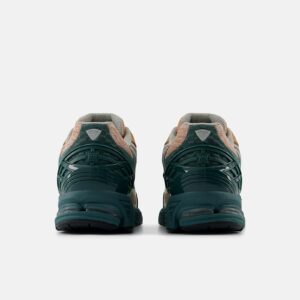In the rarefied space where nostalgia, performance, and fashion intersect, few collaborations have garnered as much cultural currency as the enduring partnership between Aimé Leon Dore and New Balance. What began in 2019 as a dialogue between downtown New York style and American athletic heritage has now matured into something far more profound—a co-authored identity that blends Teddy Santis’ polished urban narrative with New Balance’s technical legacy. This season marks a landmark evolution in that partnership with the debut of the Aimé Leon Dore x New Balance RC56: a fully original silhouette that breaks from retro revivals and steps into new terrain.
This isn’t another reinterpretation of a 990 or a reupholstered 550. This is something purpose-built and unmistakably new.
Breaking from the Archive: The RC56 as Original Expression
Up until now, Aimé Leon Dore’s sneaker catalog with New Balance has been steeped in archival reverence. Whether restoring the understated glory of the 997 or elevating the once-obscure 550 into an industry staple, ALD has mastered the art of sartorial revivalism. But the RC56 changes that. It’s not a remix; it’s a debut. It doesn’t just draw from the past—it constructs a future.
Visually, the RC56 looks like it belongs in the early 2000s: bulky yet streamlined, athletic but refined. It channels the utilitarian confidence of long-distance running shoes with the luxury finesse that’s become synonymous with ALD. At its core, it fuses New Balance’s cross-country running DNA with ALD’s vision of streetwear as a cultured, elevated craft.
Each of the three launch colorways—Neon/Grey, Pristine, and Navy—brings a different personality to the silhouette. Neon/Grey pushes a techwear-forward aesthetic with high-contrast hits that recall racing kits and energy gels. Pristine feels like a crisp white Oxford reimagined in sneaker form, subdued and elegant. Navy, a hallmark in ALD’s palette, brings the timelessness of collegiate sportswear and preppy minimalism into focus.
Materials and Movement: A Blend of Texture and Function
The upper design of the RC56 features perforated leather, nylon mono mesh, and synthetic overlays. These aren’t just design flourishes—they’re a tribute to performance roots. Every panel has a purpose. The nylon mesh provides breathability; the leather structure adds form; the synthetic trimmings offer durability and directional shape. Visually, it’s multi-dimensional, rich in texture, and packed with detail for those who appreciate construction as much as aesthetics.
Beneath the surface, performance engineering quietly powers the experience. The FuelCell midsole, one of New Balance’s most advanced cushioning technologies, provides responsive energy return without the bulk. Meanwhile, a PU foam footbed ensures daylong comfort—a nod to ALD’s urban clientele who walk, not ride, through the cityscape.
This technical-meets-tactile composition defines the RC56. It’s a sneaker that feels like a jog through the West Side Highway and a walk up Fifth Avenue all in one. Whether you wear them to run errands or reroute your day, they’re built to perform—functionally and stylistically.
Branding and Packaging: The Details That Speak Volumes
Though it avoids being overtly loud, the RC56 still communicates clearly through detail. Co-branded logos appear with deliberate subtlety across the tongue, heel tab, footbed, and even the packaging. These aren’t the typical in-your-face badges of collaboration; they’re refined markings, quietly assertive, much like the clothes Aimé Leon Dore is known for.
The packaging itself is a collector’s moment. Each pair arrives in a bespoke box, marrying ALD’s visual codes with New Balance’s athletic provenance. It’s not just wrapping—it’s part of the product experience, aligning with the brand’s belief that lifestyle is holistic, not segmented.
A Long-Term Dialogue, Not a Flash-in-the-Pan
What distinguishes ALD x New Balance from many fleeting collaborations is its consistency and evolution. Teddy Santis, who now serves as New Balance’s Creative Director for Made in USA, has never treated these collabs as one-off stunts. They are progressive chapters in a developing narrative of style, movement, and identity.
From the ALD 990v5s to the headline-grabbing 550 relaunch, each drop has built trust and anticipation. But the RC56 raises the stakes by showing that this partnership isn’t just about refining old icons—it’s about inventing new ones. And that’s what makes this release historic. Not because it’s hyped, but because it feels inevitable in hindsight. Like all great design, it leaves you wondering why it didn’t exist before.
Availability and Cultural Impression
The RC56 will be released on May 23rd, but sneakerheads and fashion devotees will need to move quickly: access is gated behind a raffle system on aimeleondore.com, which closes on May 21st. In the current landscape of controlled scarcity and carefully choreographed drops, this method isn’t surprising. What matters more is the audience ALD commands—one that blends high fashion followers, footwear collectors, streetwear historians, and downtown creatives alike.
And with that, Aimé Leon Dore continues to blur the lines between performance and prestige. The RC56 isn’t just a shoe—it’s a cultural object. A wearable hypothesis on where American sportswear is headed next.
Flow
In a time when most shoe flow chase nostalgia, the Aimé Leon Dore x New Balance RC56 dares to do something rare: create from scratch. It honors legacy, yes—but more importantly, it adds to it. With original tooling, fresh aesthetics, and refined detailing, the RC56 isn’t just a new chapter—it’s a new blueprint.
It reminds us that the best unions don’t scream—they resonate. And the RC56 resonates with quiet precision, whispering to those who understand the language of craft, context, and culture. It’s not just ALD’s first original sneaker with New Balance—it’s a declaration of creative maturity. And it’s one we’ll be seeing—and wearing—for years to come.
No comments yet.








